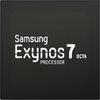
Samsung Galaxy S6 Edge+ Smartphone Review
Samsung Exynos 7420 Octa | ARM Mali-T760 MP8 | 5.70" | 153 g

The Samsung Exynos 7420 Octa (also called Exynos 7 Octa) is a high-end system-on-a-chip (SoC) for smartphones and tablets. It was launched in March 2015 alongside the Samsung Galaxy S6 and features four Cortex-A57 cores clocked at up to 2.1 GHz. Furthermore, there are four additional Cortex-A53 cores at up to 1.5 GHz, an ARM Mali-T760 MP8 GPU and a 2x 32 bit LPDDR4-3104 memory controller (up to 24.8 GB/s). It is one of the first fully 64-bit capable ARM SoCs for Android devices.
Processor
Cortex-A57 and Cortex-A53 represent the successors of the Cortex-A15 and Cortex-A7 architecture. In addition to some small tweaks leading to a somewhat higher performance per clock, both Cortex-A57 and -A53 are now 64-bit capable ARMv8 designs (Cortex-A15 and -A7: 32 bit ARMv7). Thanks to its advanced 14 nm process, clocks and performance of the Exynos 7420 are quite stable even in long-lasting benchmarks. Overall, the cpu performance is above the Nvidia Tegra K1 or Qualcomm Snapdragon 810.
While the powerful Cortex-A57 cores will handle complex software and games, the SoC can switch to the more efficient Cortex-A53 cluster in less demanding applications. If necessary, it's possible to activate individual cores from each cluster or even all eight cores at the same time. This concept developed by ARM is known as "big.LITTLE" and intended to improve the battery life.
Graphics
The Exynos 7420 integrates a Mali-T760 MP8 GPU, which offers eight shader clusters clocked at up to 772 MHz (302 GFLOPS). The Mali-T760 supports OpenGL ES 3.1, OpenCL 1.1 and DirectX 11 and offers a performance above the Adreno 430 (Snapdragon 810) or PowerVR GX6450 (Apple A8). Thus, the GPU is one of the high-end solutions as of 2015 and can handle even the most demanding Android games in high resolutions (Galaxy S6: 2560 x 1440 pixels) and detail settings.
Power Consumption
The Exynos 7 Octa is the first smartphone SoC to be manufactured in a 14 nm process with FinFETs (Samsung LPE). Therefore, the Exynos 7420 is one of the most energy efficient chips in early 2015 and runs much cooler than the competing Qualcomm Snapdragon 810.
| Codename | Cortex-A57/-A53 | ||||||||
| Series | Samsung Exynos | ||||||||
Series: Exynos Cortex-A57/-A53
| |||||||||
| Clock Rate | 2100 MHz | ||||||||
| Number of Cores / Threads | 8 / 8 | ||||||||
| Manufacturing Technology | 14 nm | ||||||||
| Features | ARM Mali-T760 MP8 GPU (773 MHz), 4x Cortex-A57 (2.1 GHz) + 4x Cortex-A53 (1.5 GHz, big.LITTLE), 2x 32 Bit LPDDR4 Memory Controller | ||||||||
| GPU | ARM Mali-T760 MP8 (700 - 772 MHz) | ||||||||
| 64 Bit | 64 Bit support | ||||||||
| Architecture | ARM | ||||||||
| Announcement Date | 03/01/2015 | ||||||||
| Product Link (external) | www.samsung.com | ||||||||





Samsung Galaxy S6: ARM Mali-T760 MP8, 5.10", 0.1 kg
Review » Samsung Galaxy S6 First Impressions
Samsung Galaxy A8 2016: ARM Mali-T760 MP8, 5.70", 0.2 kg
External Review » Samsung Galaxy A8 2016
Samsung Galaxy Note 5 SM-N920A: ARM Mali-T760 MP8, 5.70", 0.2 kg
External Review » Samsung Galaxy Note 5 SM-N920A
Samsung Galaxy S6 Edge+: ARM Mali-T760 MP8, 5.70", 0.2 kg
External Review » Samsung Galaxy S6 Edge+
Samsung Galaxy S6 Active: ARM Mali-T760 MP8, 5.10", 0.2 kg
External Review » Samsung Galaxy S6 Active
Samsung Galaxy S6 Edge: ARM Mali-T760 MP8, 5.10", 0.1 kg
External Review » Samsung Galaxy S6 Edge
Samsung Galaxy S6: ARM Mali-T760 MP8, 5.10", 0.1 kg
External Review » Samsung Galaxy S6
» Mobile CPU Comparison
Comparison of all mobile CPU series
» Mobile Processors - Benchmarklist
Benchmarklist of all known CPUs that are used in laptops (desktop and laptop CPUs)
Top 10 Laptops
Multimedia, Budget Multimedia, Gaming, Budget Gaming, Lightweight Gaming, Business, Budget Office, Workstation, Subnotebooks, Ultrabooks, Chromebooks
under 300 USD/Euros, under 500 USD/Euros, 1,000 USD/Euros, for University Students, Best Displays
Top 10 Smartphones
Smartphones, Phablets, ≤6-inch, Camera Smartphones